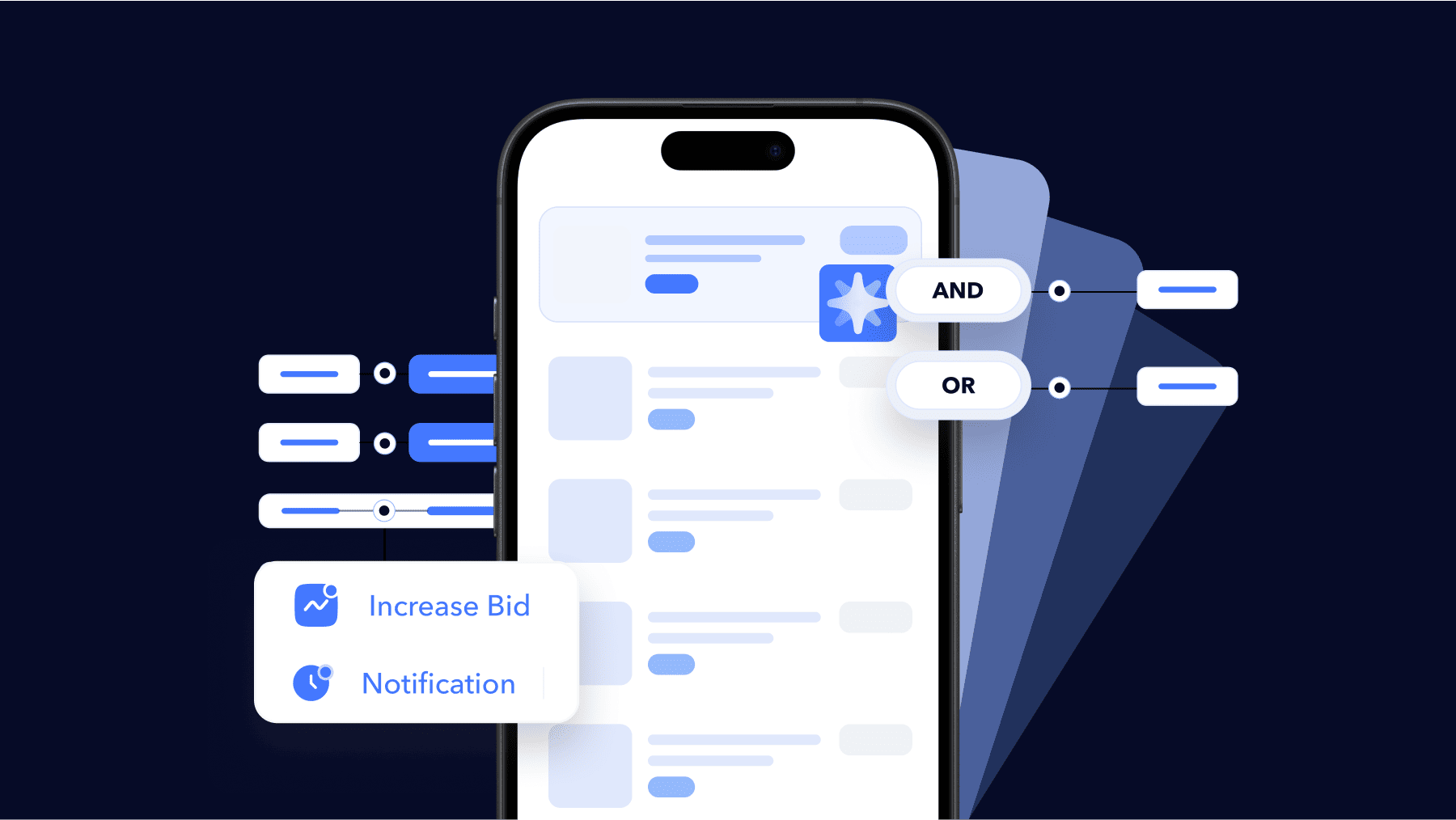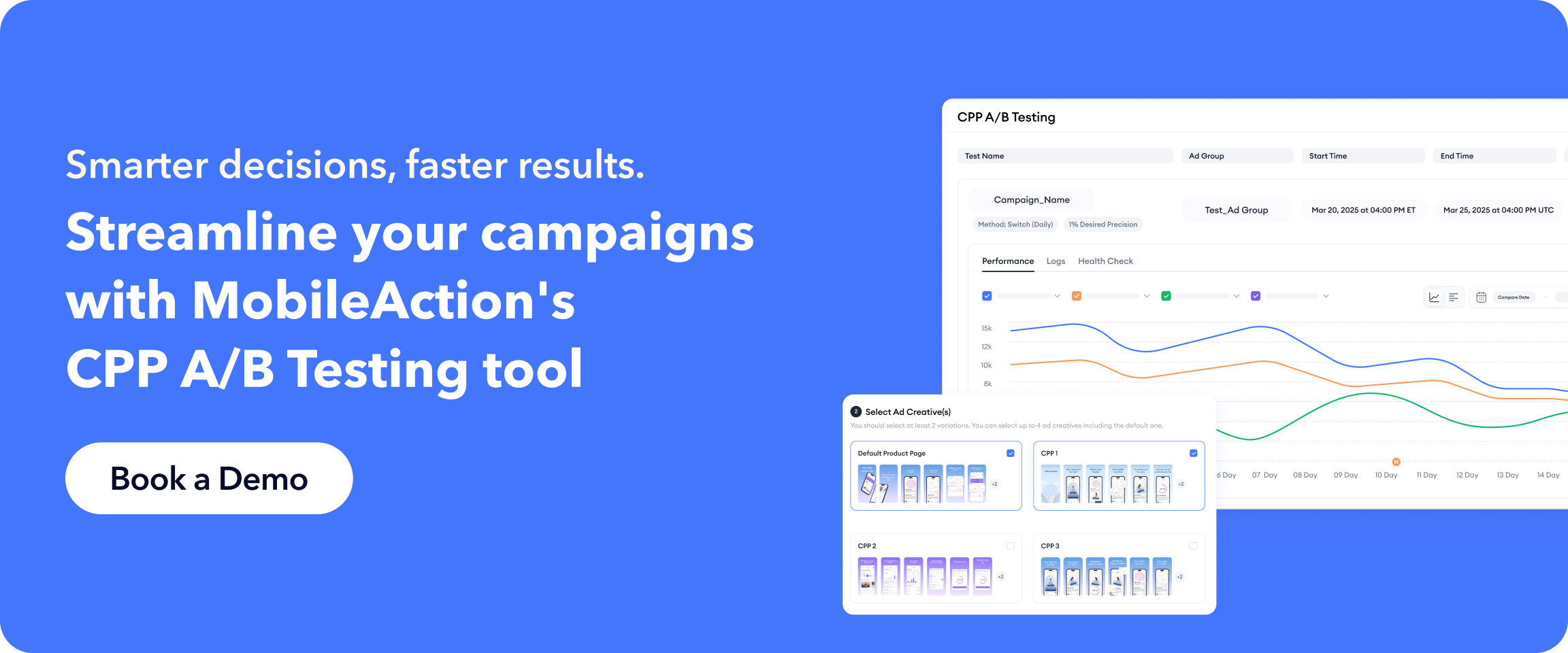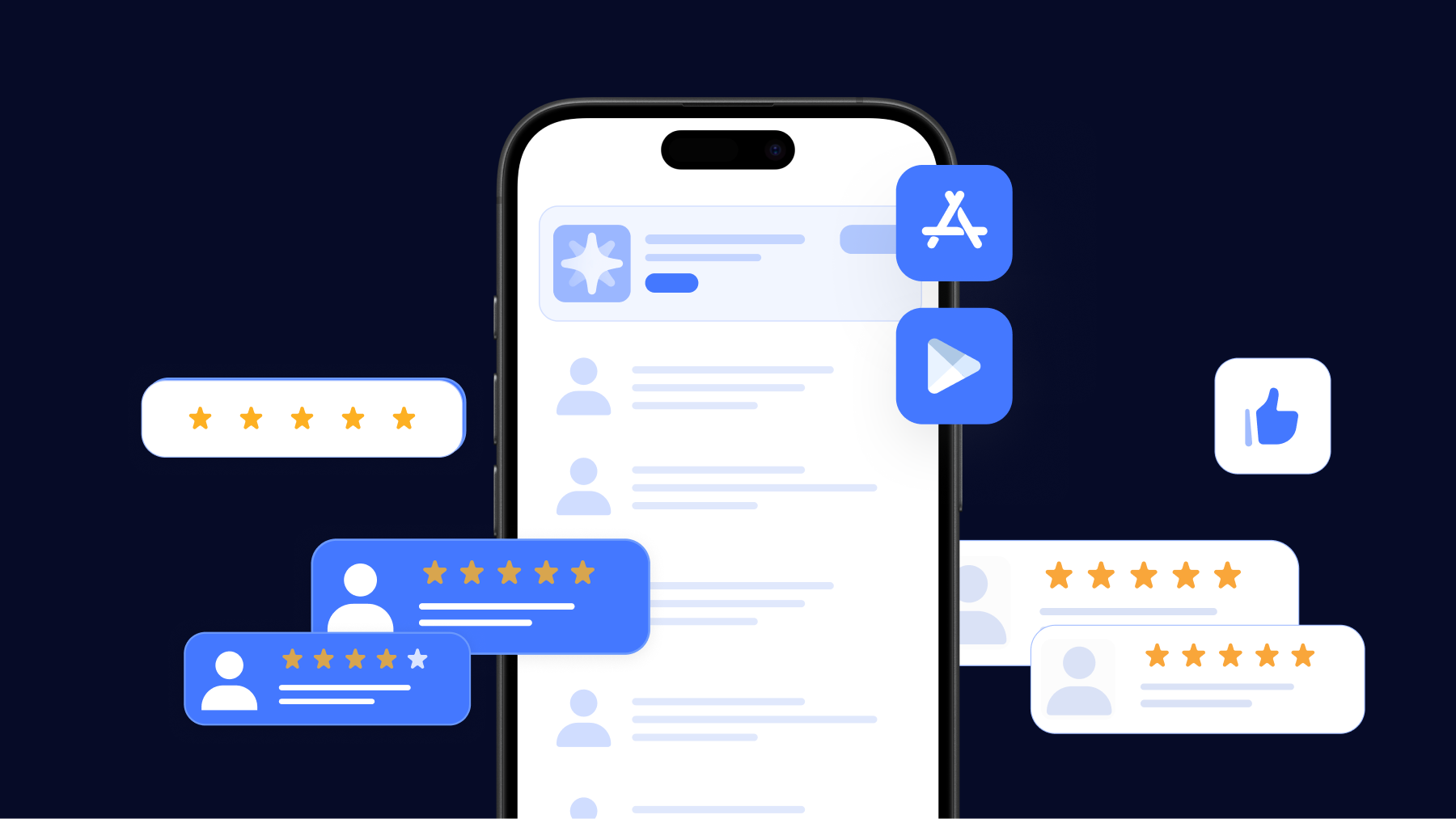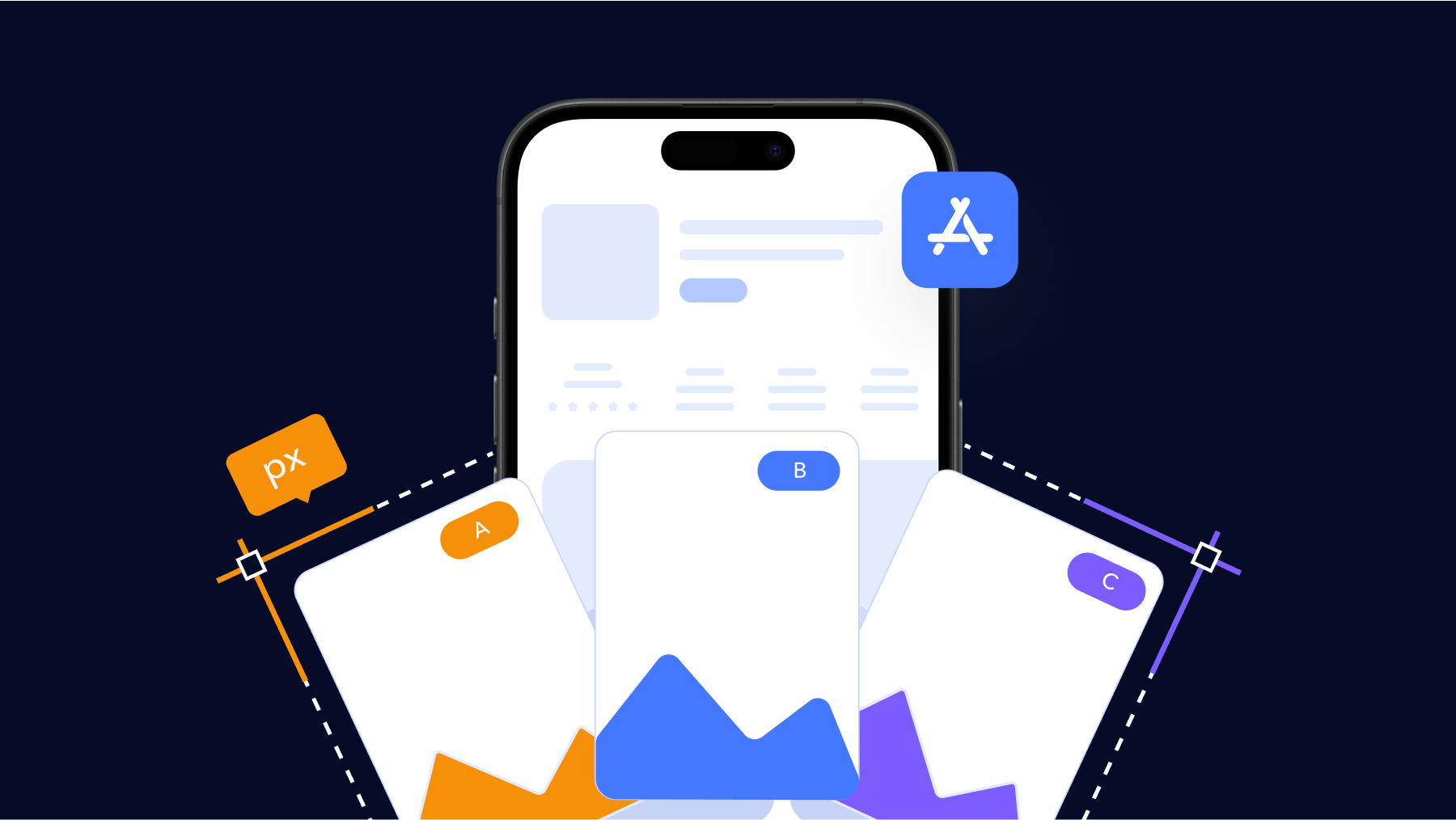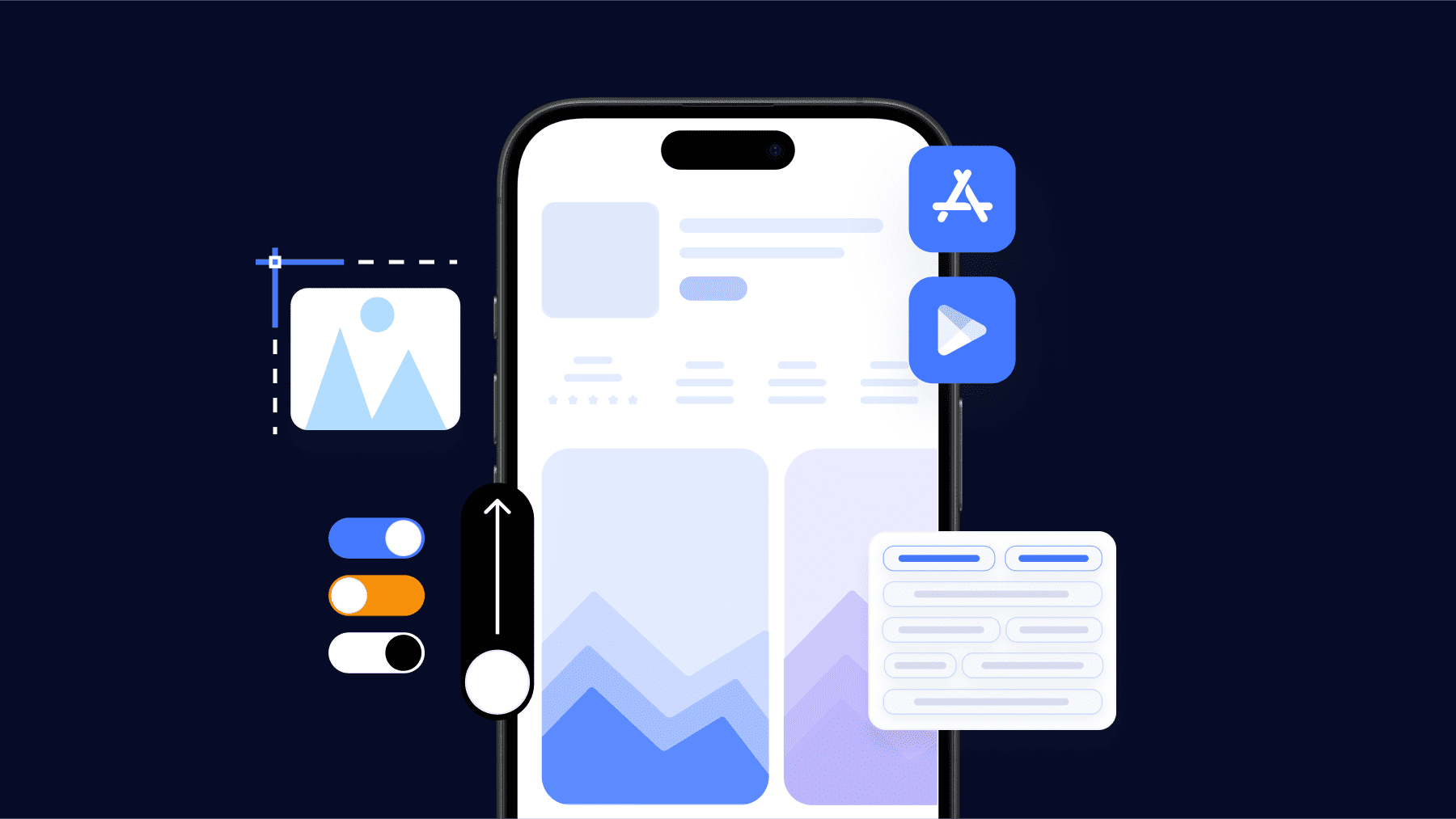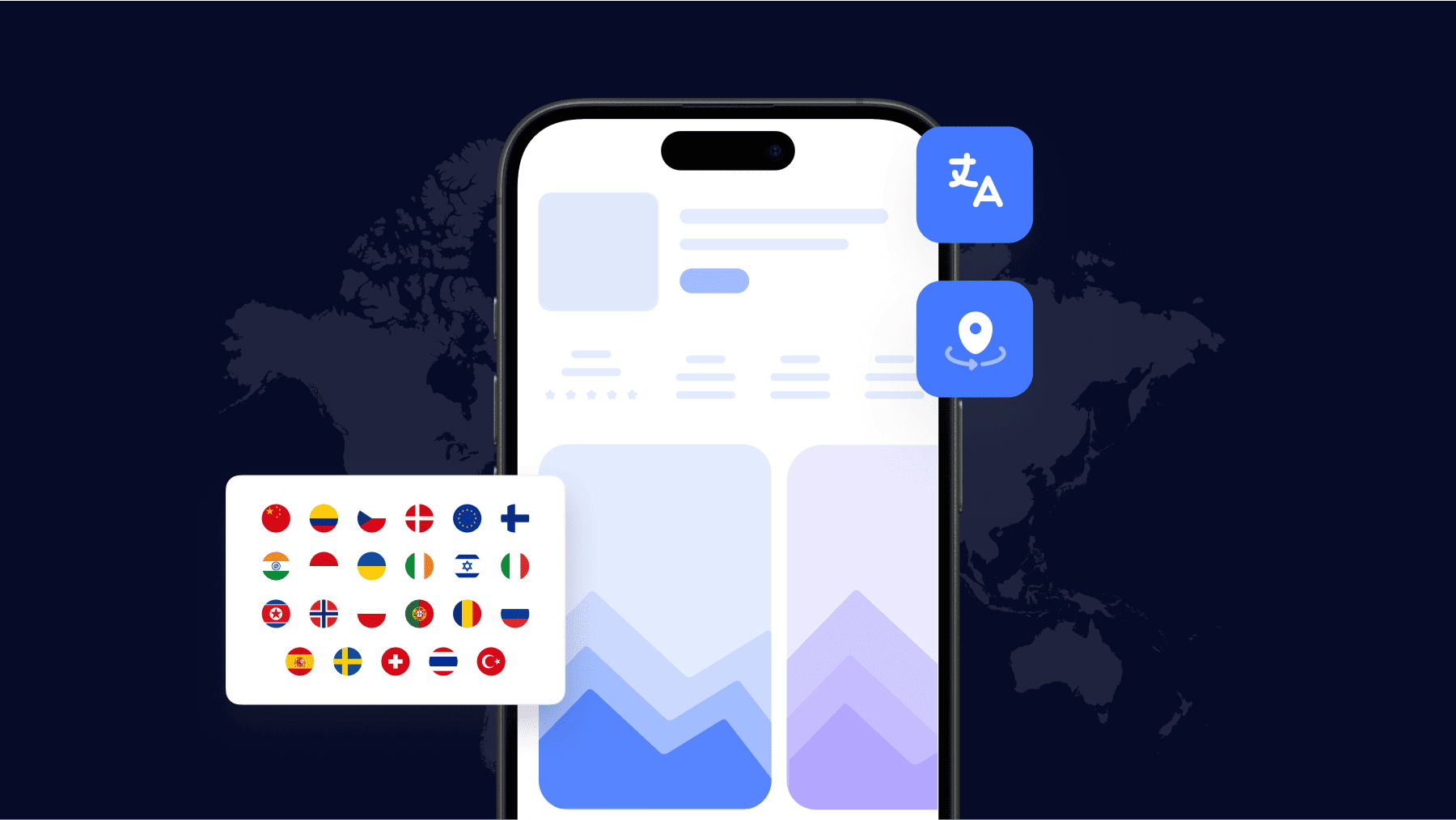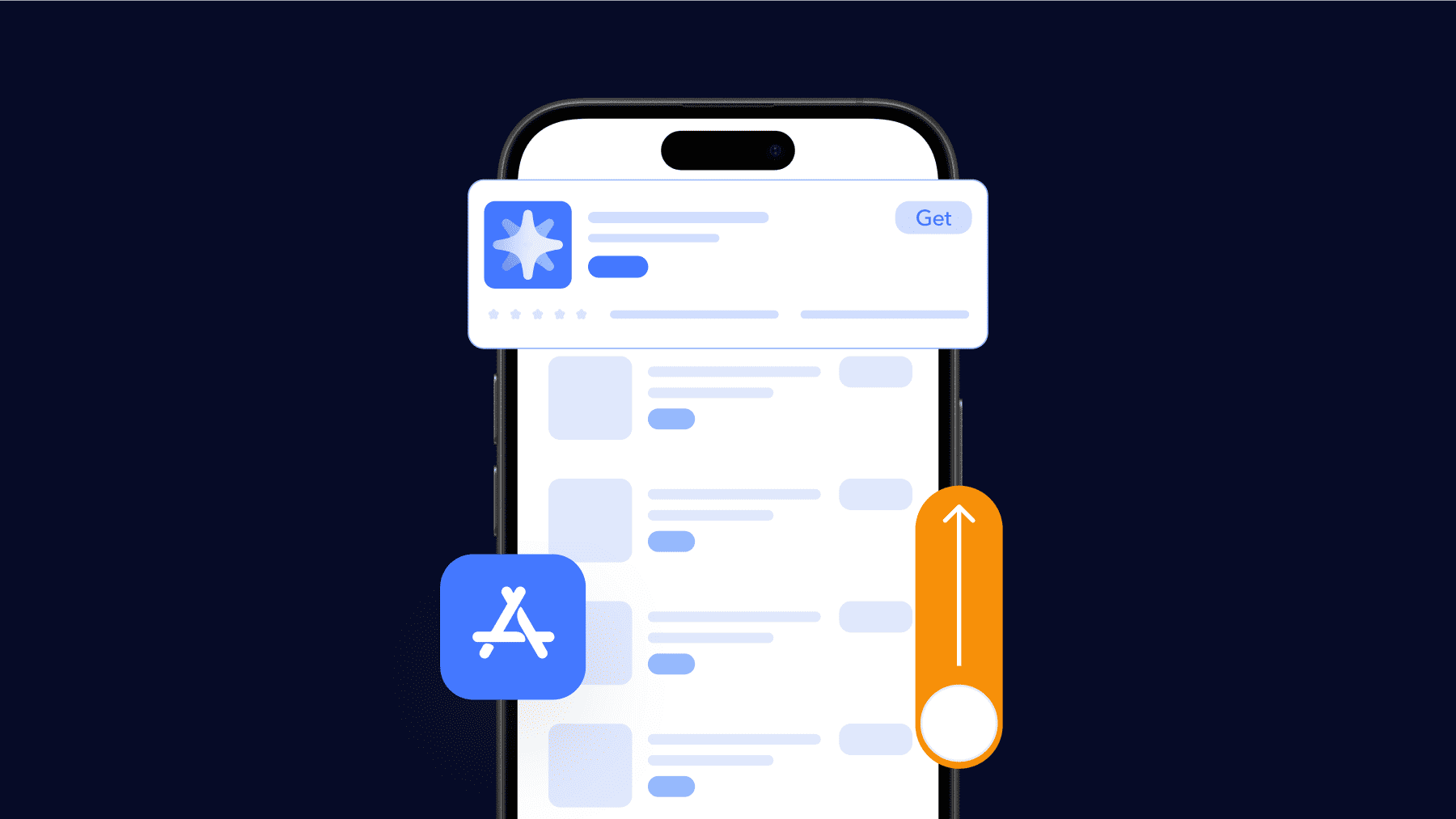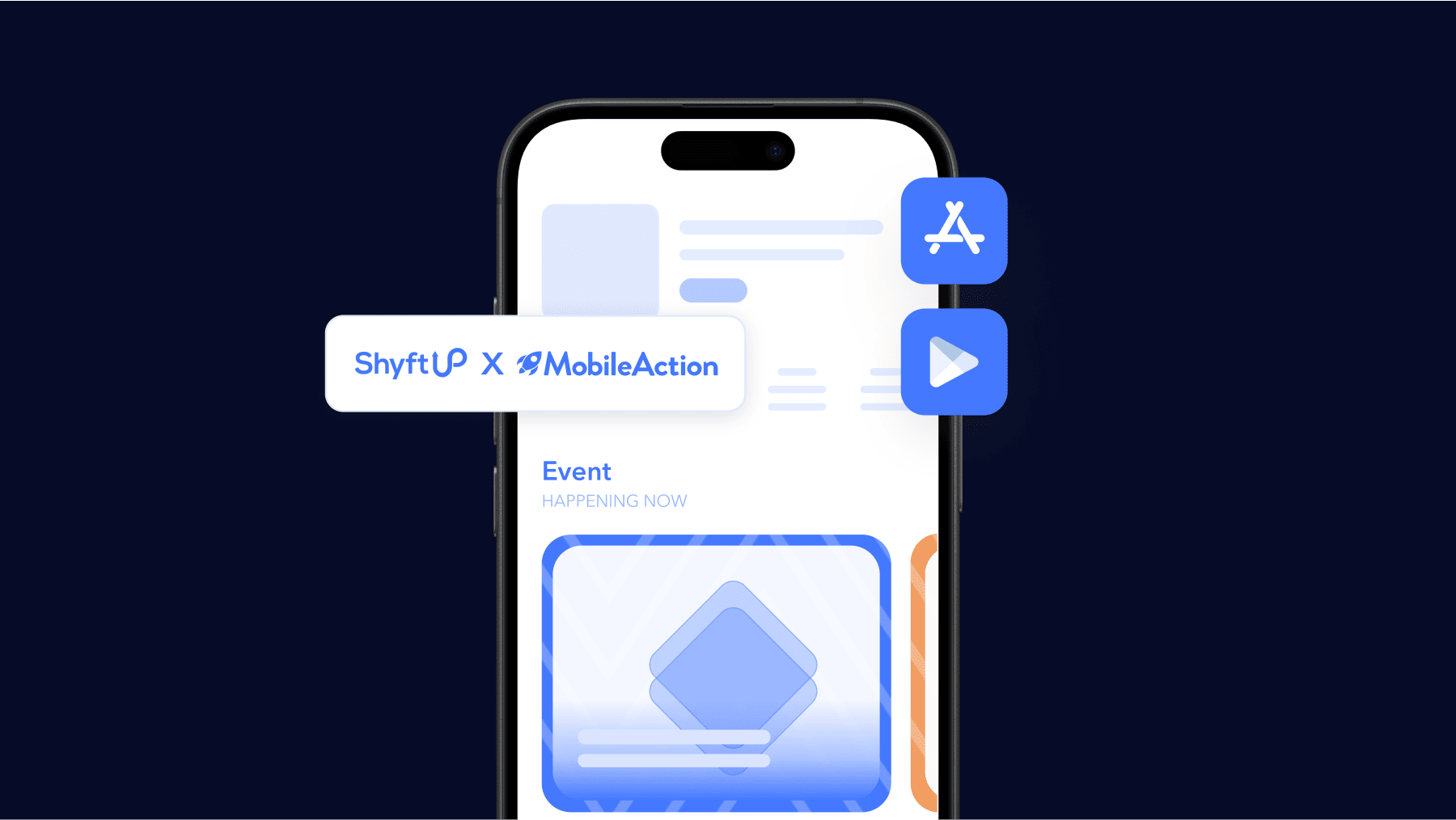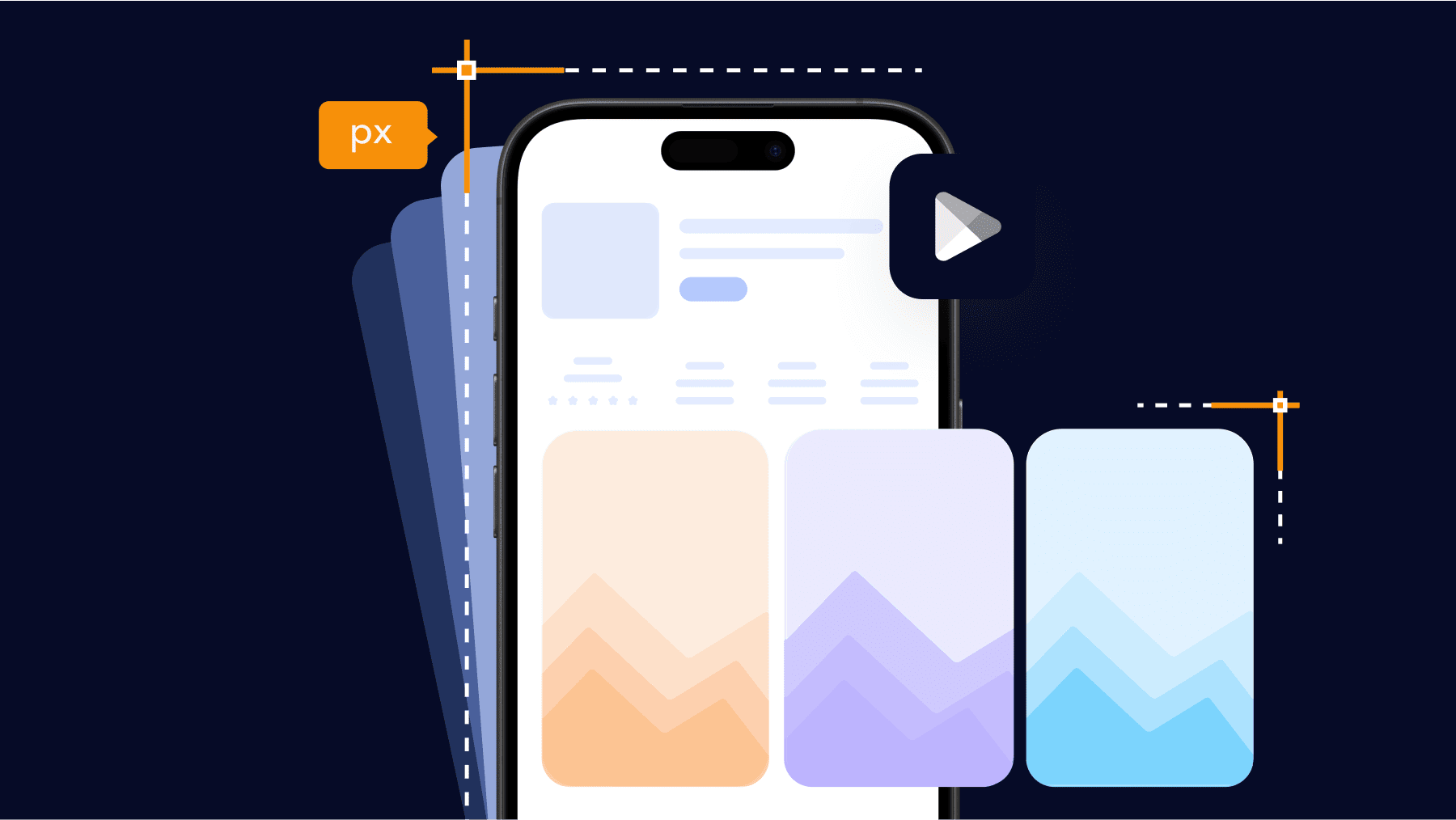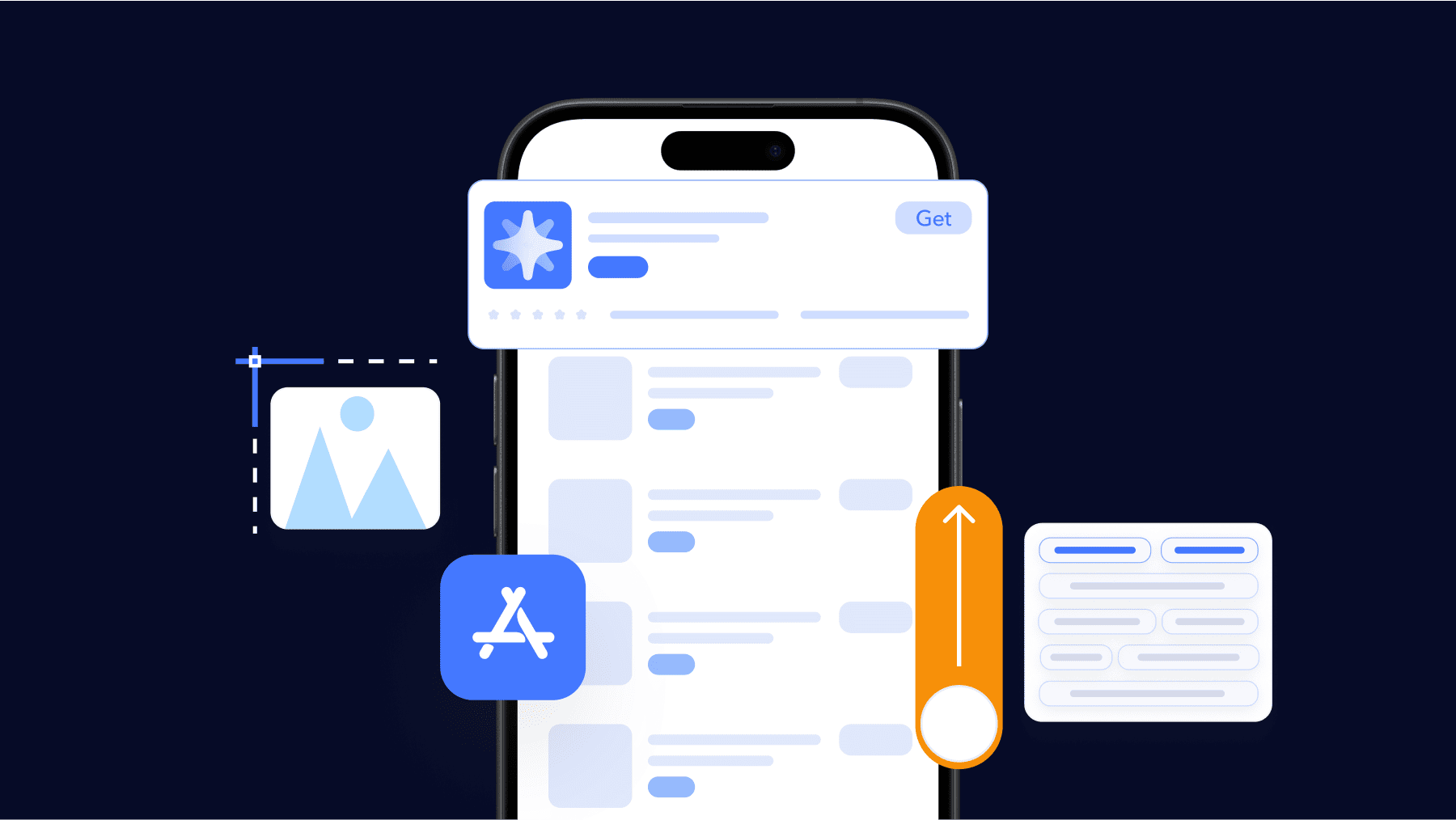This handbook will serve as your roadmap, packed with emerging trends, valuable insights, and the best ASO tools & resources. It aims to help you stay ahead of the competition and enhance your app marketing strategy for substantial growth in 2025 and beyond.
Managing all your campaigns individually, constantly checking them, and deciding what actions should be taken for each is complex and time-consuming. Especially considering you have numerous campaigns.
This comprehensive guide is your step-by-step guide to mastering MobileAction’s Automations for Apple Ads. It will guide you through setting up automations, adjusting them to fit your needs, and using them to keep your campaigns running smoothly, as well as outline the outcomes you can achieve by utilizing MobileAction’s Apple Ads automations. Whether you’re trying to increase your app’s visibility, spend your budget more wisely, or just save time on day-to-day operations, Automations can help.
Throughout this guide, we’ll walk through real-life scenarios, share best practices, and offer pro tips to help you make the most out of Automations. Our goal is simple: to help you improve your campaign performance and meet your marketing objectives more easily for Apple Ads. So, if you’re wondering how to automate Apple Ads campaigns, let’s start!
What is automation in Apple Ads?
Automation in Apple Ads is the practice of running your account with predefined rules and workflows so routine optimization happens without constant manual checks. Instead of adjusting settings one by one, you define conditions and actions that execute automatically.
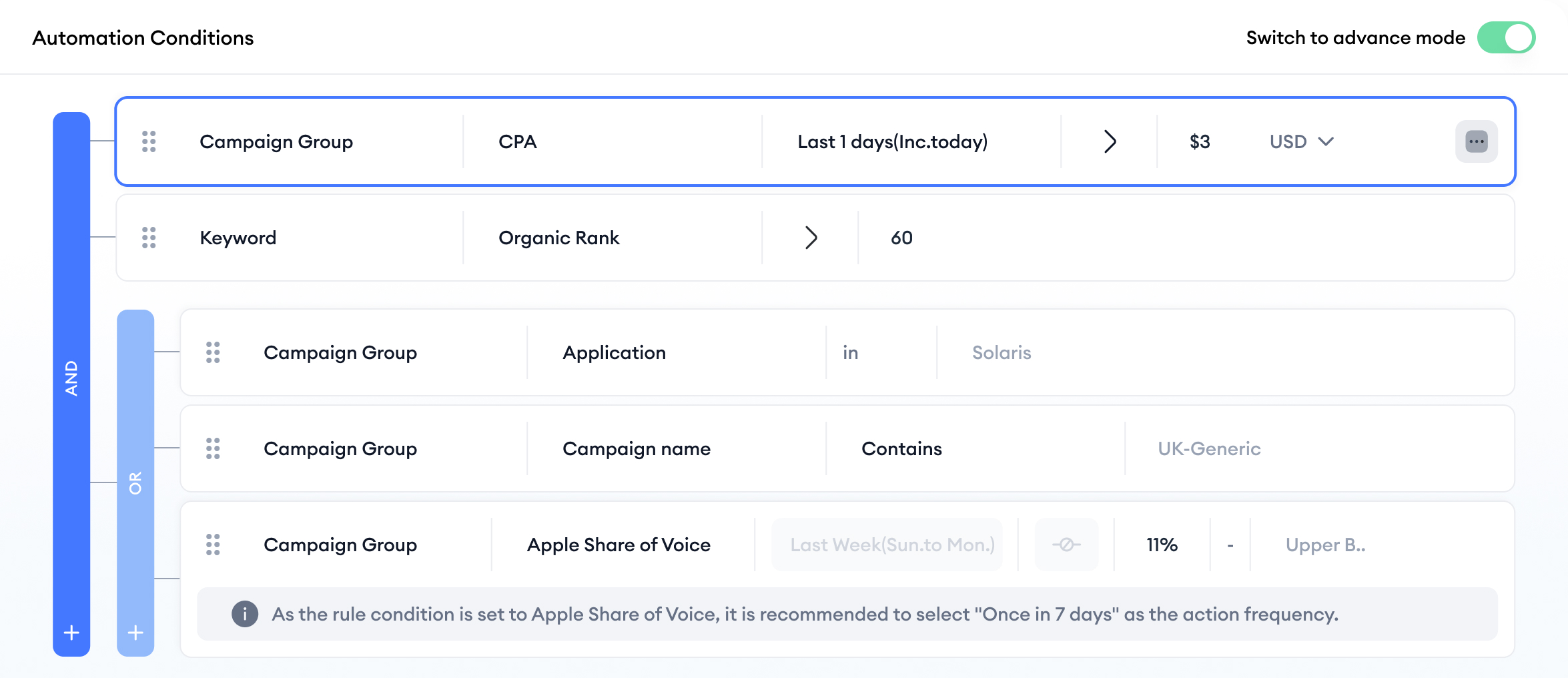
For example:
- When conversion rates drop during specific hours, automatically pause underperforming ad groups
- If a competitor keyword starts converting above the threshold, increase its daily budget allocation
- When new search terms generate installs below the target CPA, promote them to exact match
- If spend velocity accelerates beyond projections, reduce bids to maintain the monthly budget
These rules run continuously in the background, evaluating your campaigns against your defined criteria and executing changes instantly. Your optimization strategy works equally well at 3 AM as it does during business hours.
Why Apple Ads automation matters?
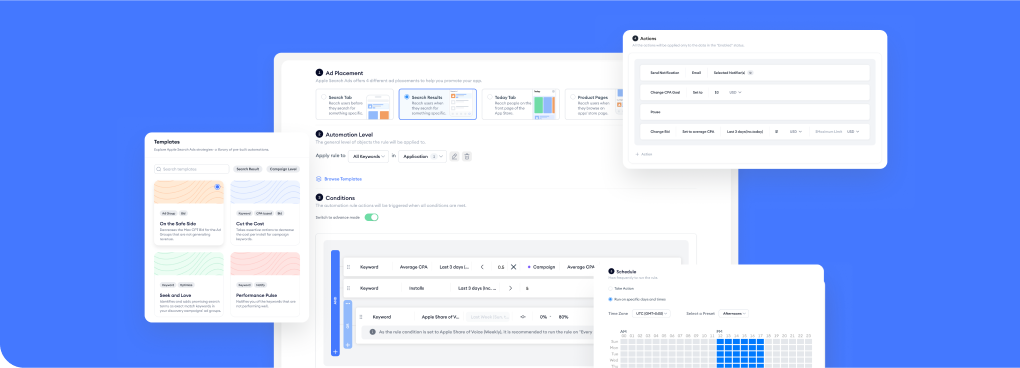
Managing Apple Ads across storefronts, placements, and account levels creates more data than anyone can track by hand. You’re watching spend, CPI/CPA, and post-install KPIs, protecting brand terms, and maintaining Share of Voice on priority keywords, while performance shifts by the hour. Manual tweaks land late, and critical signals get missed.
Automation makes the system predictable and efficient. Rules monitor the metrics that matter and act the moment conditions are met, tightening bids, re-pacing budgets, promoting or pausing keywords, adding negatives, and alerting you when performance drifts, so you prevent waste instead of reacting to it.
The payoff is control at scale. The same logic applies across every campaign, every day, improving visibility, safeguarding brand terms, and freeing time to test and iterate faster. As you add markets or apps, automation carries your standards forward without multiplying the workload.
So basically, the Automations for Apple Ads help you overcome these obstacles;
- Lack of visibility and control over campaign performance
- Difficulty in making timely adjustments to campaigns
- Inefficient use of resources and budget
- Challenges in maintaining brand protection
- Inability to quickly test and iterate on campaigns
What are the things you should consider before automating Apple Ads?
Before you let rules make changes on your behalf, make sure you have a solid understanding of the fundamentals below. Each one directly affects how reliably your automations behave and how confidently you can scale.
-
Metrics
Automations are only as good as the metrics they monitor. Ensure you know which metrics matter most for your app’s success, especially post-install metrics like in-app purchases, subscriptions, or retention.
4 metric types can be utilized while building automations.
- Basic metrics: Fundamental metrics, such as Impressions, Taps (clicks), Installs, and Conversion Rate, form the foundation of campaign analysis.
- Cohort metrics: Cohorted performance data that you define (e.g., Day 7 ROAS, Week 1 retention), allowing analysis based on install cohorts.
- Custom metrics: Your own calculated metrics or KPIs. Automations support custom formulas or fields, allowing you to optimize for what matters most to your app.
- Organic performance metrics: Particularly for keyword-level rules, you can include organic metrics like Organic Rank or Keyword Popularity. This helps create a holistic user acquisition strategy by considering organic performance alongside paid performance.
These metrics are the focus of most automation rules. For example, if you’re optimizing for a target CPA or ROAS, you’ll need reliable data on conversions beyond the install.
Knowing how to interpret metrics like conversion rate, cost-per-install, cost-per-acquisition, and day-7 ROAS will help you set the right conditions in your rules.
-
Campaign structure and organization
A transparent campaign structure is the backbone of effective automation. Before automating, make sure your Apple Ads account is organized in a logical, granular way. This means structuring campaigns by themes (for example: brand, category, competitor, discovery) and having clear naming conventions for campaigns, ad groups, and keywords.
A clean structure not only helps you monitor performance manually, but it also ensures that automation rules apply to the correct scope.
-
Typical workflow and task priority
Understand your workflow in Apple Ads and identify which repetitive tasks consume most of your time. This will highlight the best opportunities to introduce automation first.
For beginners, it’s wise to start automating the simple tasks you find yourself doing daily or weekly, such as routine checks and adjustments. This could be pausing keywords that spend too much without converting, increasing bids on high-ROAS keywords, or sending alerts when spend hits a certain threshold.
-
Bidding principles and strategy alignment
Before creating automated bid rules, learn how the auction in Apple Ads works and how bid changes affect your results. This includes understanding the cost-per-tap (CPT) model, how Suggested Bids are determined, and how bids correlate with impressions and conversions for your keywords.
With this knowledge, you can set proper bid thresholds and targets in your Automations. For example, if you know your optimal CPT or CPA, you can create rules to increase bids when performance is efficient (to capture more volume) and decrease bids when costs creep too high.
What are the Apple Ads automation types?
How to automate Apple Ads can be answered by listing categories covered by campaign management automation. Here are the main types of Apple Ads Automations and what they do:
1. Campaign structure automations
These automations focus on managing the structure of your campaigns. They help organize and refine your account by moving elements around or adjusting their status. You can set up rules to automatically transfer successful search terms into exact-match keywords in your main campaigns.
This ensures your discovery campaigns continuously feed your core campaigns with fresh, high-performing keywords. Other structural automations include adding negative keywords for irrelevant queries (to cut wasteful spend), splitting out high-volume keywords into their own ad groups, or even pausing/activating entire campaigns based on a schedule or an event.
2. Campaign performance automations
Performance-focused rules aim to maximize results and efficiency by reacting to your key performance indicators. These automations monitor metrics like CPI, CPA, conversion rate, ROAS, and take action to hit your targets.
For example, you might have a rule that pauses an ad group or keyword if its CPA goes 50% above your goal, stopping the bleeding on underperformers. Conversely, another rule could increase the budget of a campaign that’s delivering installs below your target CPI, so you scale up what’s working.
3. Discovery automations
Discovery automations help you continuously uncover and capitalize on new keywords without manual research. Apple Ads has Discovery campaigns (using broad match and Search Match) to find new search terms, and automations can make the most of them. With rules in place, you can automatically identify high-potential search queries and promote them to permanent keywords.
Let’s say that a Search Match term generated a few installs at a great CPA, an automation rule could add that term as an exact-match keyword in a dedicated campaign (and optionally notify you or apply a higher bid to test its full potential).
On the flip side, discovery automations can also trim out the noise, e.g., auto-negate search terms that spent a lot but never converted, so your budget is reallocated to better opportunities.
4. Bid management automations
Bid management is one of the most popular automation types, because getting bids right is crucial and often labor-intensive. Bid automations automatically adjust your keyword or ad group bids based on performance criteria you define. The goal is to keep your bids optimized around the clock.
Some examples: a rule to increase bids by X% on keywords that have a high conversion rate or low CPA (to get even more volume from those), a rule to lower bids on keywords that are overspending (e.g., high spend with no conversions or a CPA above target).
5. Budget and spend automations
Budget-focused automations help control how your money is allocated and make sure you don’t run out of steam (or overspend) unexpectedly. Budget automations can adjust campaign daily budgets, total budgets, or reallocate spend based on conditions.
These automations remove the need to constantly watch and tweak spend throughout the day. They ensure that your campaigns have the right budget at the right time, and that you stay within overall spend limits you’re comfortable with, all without manual intervention on a daily basis.
6. Productivity and alert automations
Not every automation directly changes a bid or budget; some are there to make your life easier by surfacing important information. Productivity automations typically involve sending alerts, notifications, or adding labels based on certain triggers, helping you stay on top of the account with less manual checking. For instance, you can set an automation to email or Slack your team if a campaign’s installs drop by more than 30% day-over-day, or if a keyword’s CPI suddenly spikes above your threshold.
While these actions don’t directly optimize your campaigns, they greatly improve productivity by focusing your attention where it’s needed most. Think of productivity automations as your virtual assistant: they watch metrics and flag the items that deserve a closer look, which complements the performance automations that are simultaneously making adjustments.
Real-life use cases on how to automate Apple Ads
To illustrate how Automations can be applied, let’s look at several real-world scenarios and how the Apple Ads automations provides solutions in each case:
1. Scaling controlled growth
Scenario:
You want to scale up your campaigns to reach more users, but you need to maintain cost-efficiency. The challenge is to increase volume (impressions, installs) without letting ROI slip, essentially growing under control so that you don’t overspend for marginal gains.
Solution:
Use Automations to systematically increase bids and budgets for high-performing elements while keeping an eye on efficiency metrics. For example, set up a rule to raise bids by a certain percentage on keywords with a Cost Per Acquisition (CPA) below your target, and automatically increase the daily budget for campaigns that maintain a Return on Ad Spend (ROAS) above a threshold. This way, as long as performance is good, the automation gradually scales your spend to capture more volume. The moment performance drops outside your targets, the rule can stop those increases (or even dial things back). This controlled scaling ensures growth with ROI optimization, allowing you to capture more users without wasting ad spend.
Suggested ruleset for this scenario:

- Condition 1: Keyword Goals ROAS (last 14 days, including today) > Campaign average Goals ROAS (last 14 days)
- Condition 2: Keyword Goals (conversions) in the last 14 days ≥ 3
- Action: Increase bid by 10%
- Attribution setting: Without re-attribution
- Level: Keyword
2. Brand protection
Scenario:
In a competitive market, maintaining your brand’s presence in search results is critical. You notice competitors are bidding on your brand keywords, risking a loss of Share of Voice (SoV) for your own brand terms. You want to ensure your app consistently appears for brand-related searches and outshines competitors in visibility.
Solution:
Automations can monitor your Apple Ads Share of Voice (SoV) metrics (the percentage of impressions your ads get for certain keywords, especially your brand terms) on a daily or weekly basis. Set up a rule that, if your brand keyword SoV falls below a certain percentage, automatically increases the bid for that keyword (or adjusts the ad group’s budget). This automation effectively defends your brand presence by reacting to competitive pressure in real time. It raises your bids when needed to regain lost share of voice, ensuring sustained brand visibility and engagement. You can also have the automation send an alert to your team when SoV drops, so you’re immediately aware of competitive threats.
Suggested ruleset for this scenario:

- Condition: If Apple Share of Voice (SoV) for a keyword in the last 1 day (including today) is between 0% and 80%
- Action: Increase bid by 5% (no max limit defined)
- Execution: Run once a day
- Level: Keyword
3. Handling high traffic and seasonality
Scenario:
Your app experiences predictable traffic spikes at certain times, for example, Health & Fitness apps might see surges on Monday mornings, or Food & Delivery apps might peak during dinner hours and weekends. Likewise, seasonal events or holidays can dramatically increase user activity. These spikes can quickly deplete budgets or lead to missed opportunities if not appropriately managed.
Solution:
Leverage Automations with dayparting and seasonal rules to adjust bids and budgets during known high-traffic periods. For instance, you can create an automation to increase the campaign’s daily budget by 30% every Saturday and Sunday, and revert on weekdays, ensuring you capitalize on weekend demand. Similarly, during a known seasonal peak (like New Year’s for a fitness app), an automation can temporarily raise your bid caps or expand the budget for the peak week. After the period passes, the automation could scale things back down. By programming these rules in advance, you can efficiently manage spend during high-traffic periods without manual monitoring, ensuring you don’t overspend during lulls or underspend during spikes.
Suggested ruleset for this scenario:
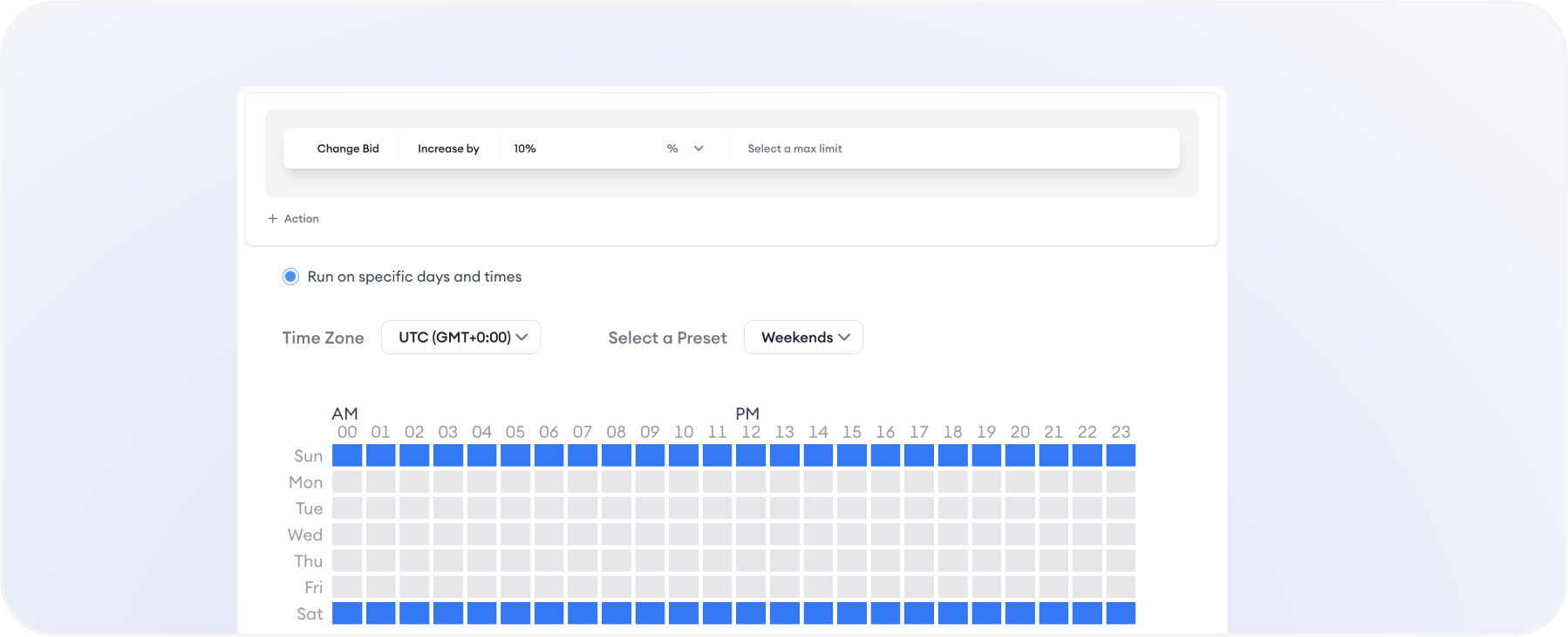
- Condition: Run on weekends (Saturday & Sunday, all hours) when CPI < $5 and Share of Voice (SOV) is between 0%–80%
- Action: Increase bids by 10% (no max limit defined)
- Level: Campaign or Ad group (depending on where applied)
- Time zone: UTC (GMT+0:00)
4. Market volatility safeguards
Scenario:
In volatile markets (for example, a cryptocurrency trading app or stock trading app), conditions can change very quickly. A sudden market drop or surge might mean you need to pause campaigns to avoid wasted spend or resume them to capitalize on interest. Manually doing this in real time is almost impossible.
Solution:
Set up Automations that respond instantly to external market signals or performance thresholds. For a crypto-related app, you might have a rule like: if the cost-per-install spikes above $X or if daily spend exceeds $Y without corresponding conversions, then pause the affected campaigns or ad groups. Conversely, when conditions normalize or a bull market begins, another automation could reactivate those campaigns and even raise bids to capitalize on the momentum. Automations act as a safeguard for your budget in turbulent times, protecting your investment and adapting to market dynamics in seconds rather than days.
Suggested ruleset for this scenario:
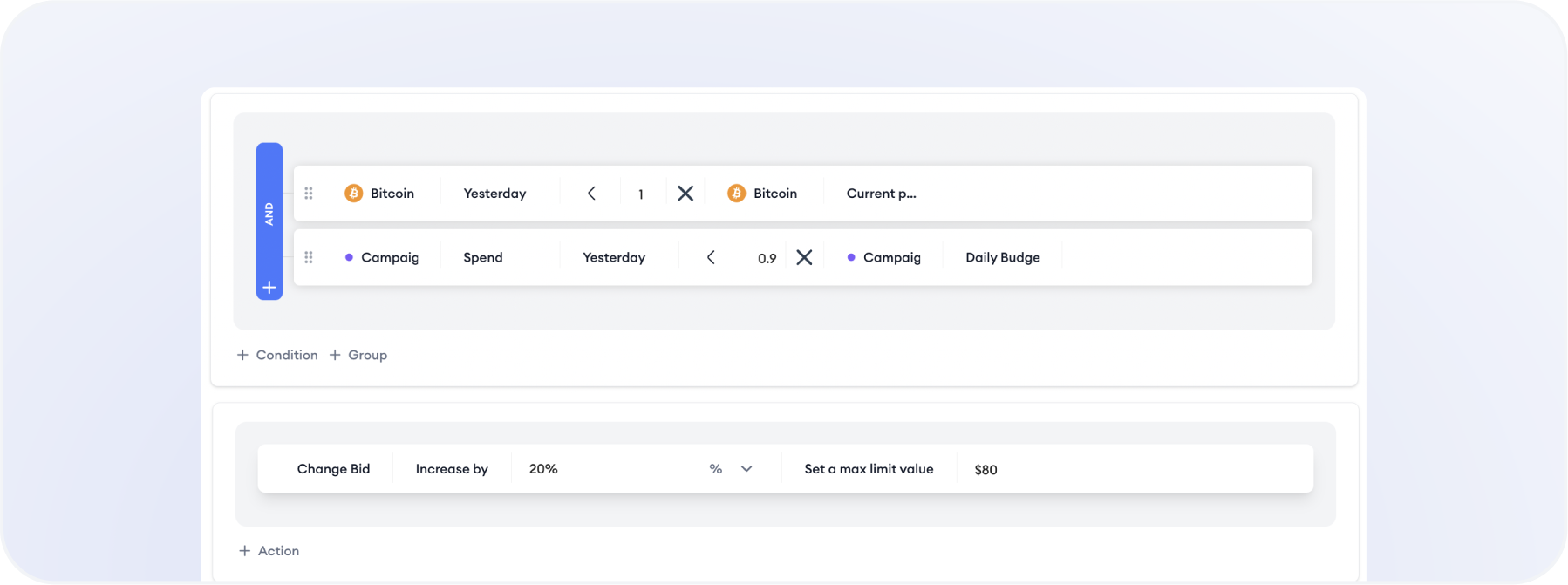
- Condition 1: If Bitcoin price yesterday < Current Bitcoin price (indicating a bull market signal)
- Condition 2: AND Campaign spend yesterday < 90% of daily budget (budget underutilized)
- Action: Increase bids by 20%, with a maximum bid cap of $80
- Level: Campaign (bid adjustment)
5. Optimizing for CPA targets
Scenario:
Your marketing goal is to maintain a specific Cost Per Acquisition (CPA) across campaigns. You may need every app install to cost $5 or less to remain profitable. This means you must continuously adjust budgets and bids to meet the CPA target as conditions change.
Solution:
Automations can help enforce CPA (or CPI) targets by making real-time adjustments. For example, configure a rule to reduce bids on keywords or pause ads in any ad group where the CPA over the last 7 days exceeds your $5 target. Simultaneously, you might have a rule to increase budget allocation to campaigns that are achieving a CPA significantly below $5 (indicating an opportunity to scale up those campaigns). These rules ensure that spending is constantly rebalanced towards the best-performing, most cost-efficient areas. Over time, this automation-driven refinement keeps your overall campaign cost-efficiency optimized and helps prevent overspending on expensive acquisitions.
Suggested ruleset for this scenario:

- Condition 1: Keyword CPA (last 3 days including today) > 1.5 × Campaign average CPA (last 3 days)
- Condition 2: Keyword installs (last 3 days including today) > 5
- Action: Decrease keyword bid by 15% (per execution)
- Level: Keyword
6. Automated A/B testing
Scenario:
You want to test different elements of your campaigns (ad creatives, keywords, audience targeting, etc.) to see what works best. Running A/B tests manually is time-consuming, as you have to manually monitor results and switch traffic to the winning variant.
Solution:
Use Automations to conduct and scale A/B tests with less manual effort. For example, say you have two versions of an ad creative (Creative A and Creative B) running in the same campaign. You could set up a rule that monitors the conversion rate or click-through rate (CTR) of the two creatives over a set period. Once a statistically significant difference emerges, an automation can automatically shift budget towards the better-performing creative (or even pause the weaker creative). Similarly, you might be testing two different bid strategies or audience refinements in separate ad groups. Automations could pause the underperforming ad group after a week and reallocate its budget to the winner. In this way, the tool automates the iterative process of A/B testing, ensuring you quickly capitalize on winners and reduce spend on losers without waiting for a manual analysis.
Suggested ruleset for this scenario:
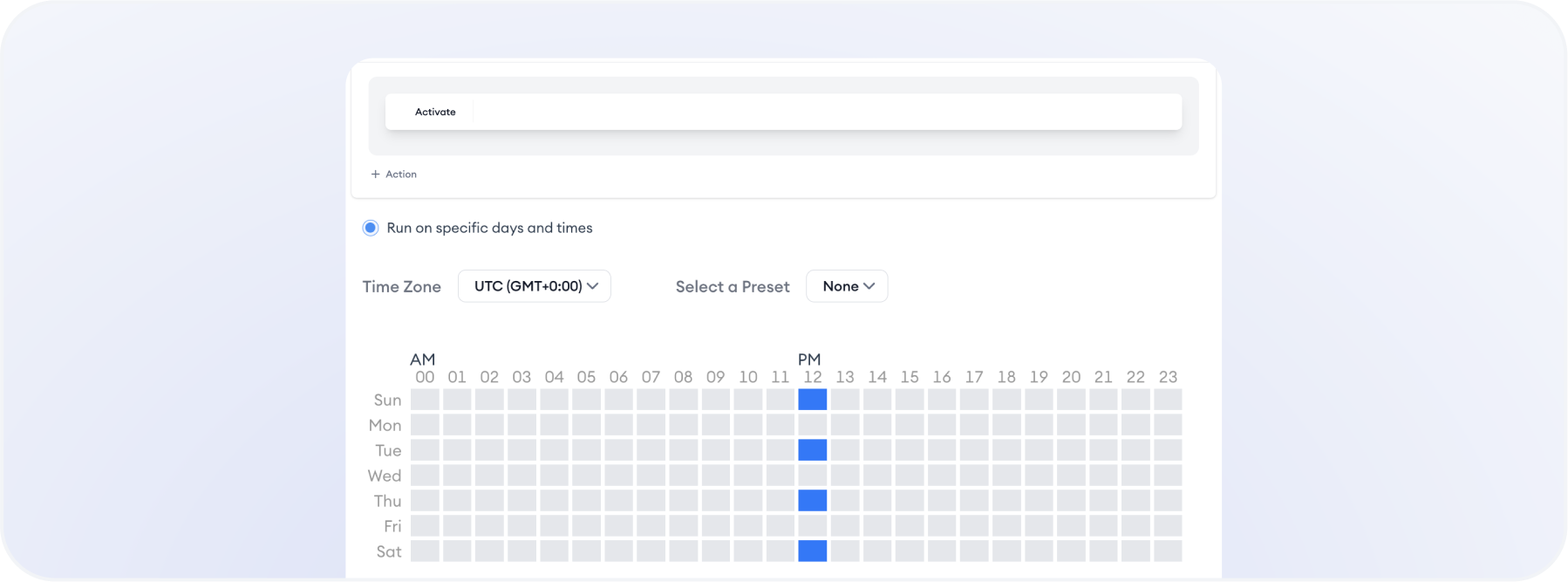
- Condition: Run only at specific times:
- Sunday at 12:00 PM
- Tuesday at 12:00 PM
- Saturday at 12:00 PM
- Action: Activate campaign/ad group
- Level: Campaign or Ad group (depending on where applied)
- Time zone: UTC (GMT+0:00)
On top of that, MobileAction’s CPP A/B Testing tool takes this even further by enabling you to run structured experiments with your custom product pages. Instead of guessing which screenshots, app previews, or promotional text drive higher conversion, you can:
- Split traffic across multiple custom product pages directly in Apple Ads campaigns.
- Measure performance by conversion rate, CPA, or downstream metrics from your MMP.
- Use Automations to scale winning custom product pages while dialing back weaker ones.
7. “Brake Mechanisms” for cost control
Scenario:
Certain high-visibility ad placements can generate a lot of impressions and spend very quickly. They’re great for exposure, but if the cost-per-acquisition spikes or an impression cap is reached, you might blow through your budget or overshoot your efficiency targets before you realize it. You need a safety mechanism to prevent overspending on these placements if performance goes away.
Solution:
Configure Automations as “brake mechanisms” for your campaigns on these aggressive placements. For example, set a rule for search result campaigns: if the campaign spends more than $X in a day OR if the CPA goes above $Y, then immediately reduce the bid by 20% (to slow down spend). Another rule might be: if impressions in a day exceed a certain number (indicating the ad is serving too frequently), then pause the ad for the remainder of the day. These automated brakes ensure that the moment a campaign starts exceeding the limits you’re comfortable with, the system taps the brakes to protect your budget. Essentially, you’re automating a fail-safe: the campaign can run at full force when performance is good, but will automatically pull back if predefined cost or volume thresholds are crossed, maintaining overall efficiency.
Suggested ruleset for this scenario:
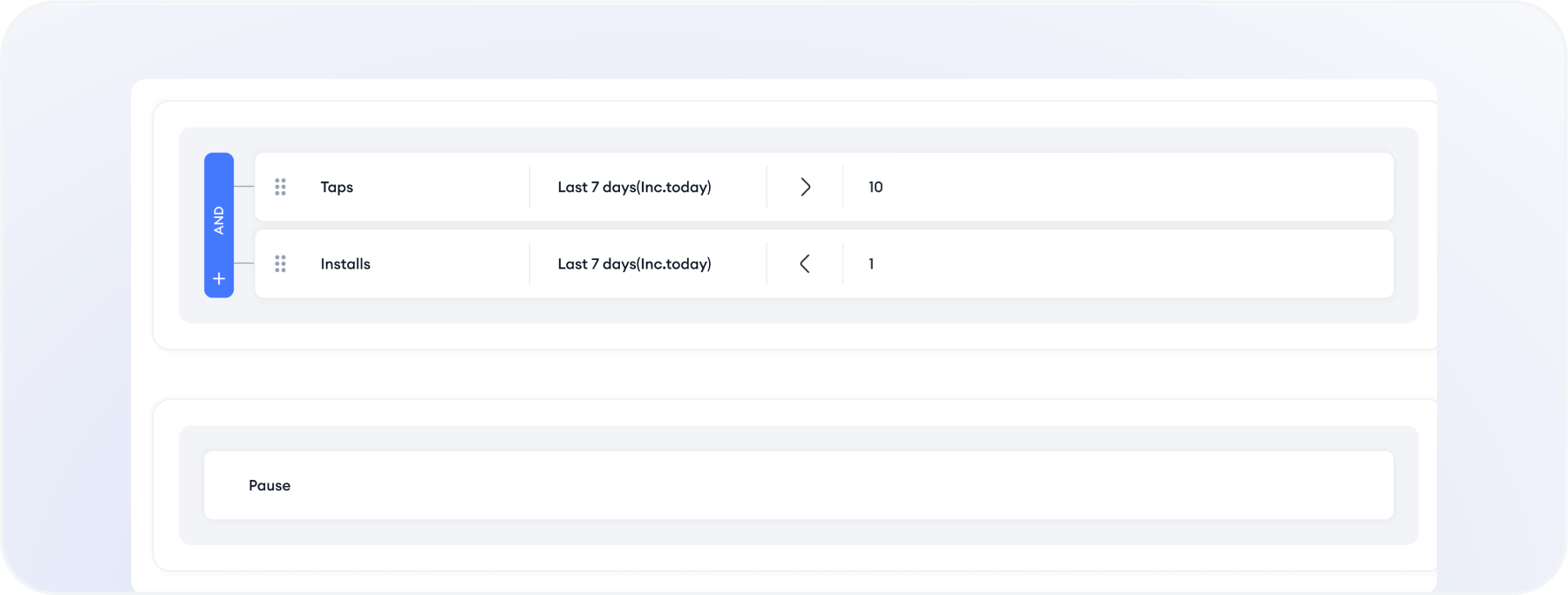
- Condition 1: If Taps > 10 in the last 7 days (including today)
- Condition 2: AND Installs < 1 in the last 7 days (including today)
- Action: Pause
Best practices for using automation in Apple Ads
Getting started with Automations is straightforward, but using it like a pro can take some practice. Here are a few quick tips for beginners to make the most of the Automations for Apple Ads:
1. Set realistic goals (and avoid over-adjusting)
Define clear, achievable campaign KPIs and decide how often you really need to make adjustments. It’s important not to tweak campaigns too frequently in reaction to normal short-term fluctuations; doing so can lead to instability and confusion. Start with modest, well-defined goals (e.g., a target cost-per-install or a daily install volume) and let your campaigns run long enough to collect meaningful data before making changes. Adjust your automation rules on a schedule that allows you to observe trends (for example, weekly) rather than reacting daily to every small change.
2. Create rules with real data
Rules should act on signal, not noise. Use 7–14 days of data (30 for slow volume) and add data floors so changes only happen with enough evidence, e.g., ≥20 taps and ≥3 installs in the lookback, plus a minimum for the post-install event you care about. For stability, consider relative thresholds (e.g., CPA > 1.5× campaign average) alongside absolute targets.
3. Start with pre-made templates
Not sure where to begin with automation rules? Take advantage of the 20+ pre-made Automations templates available. These templates are designed for common campaign goals and scenarios (like pausing low-performing keywords, boosting budget on high ROAS campaigns, etc.), providing a solid starting point. You can simply select a template that matches your objective and activate it. This lets you see immediate benefits while you learn how Automations works.
4. Keeping growth and effectiveness in balance
If you raise bids/budgets when performance is efficient, add a rule that trims bids or pauses when costs drift above target. For brand terms, set a visibility floor (e.g., SoV ≥ 80–90%) and a relief valve that eases bids once you’re back above the line. This keeps you visible without letting spending run away.
5. Regularly check automation logs
Make it a habit to review the Automations Logs to ensure your rules are functioning as intended. The logs will show each time an automation ran, what conditions were evaluated, and what actions were taken (if any). This is especially useful for beginners to confirm that their automations are hitting the correct targets. By examining the logs, you can understand how your configuration is affecting campaign performance and adjust the rules as necessary. If something isn’t triggering when expected, the logs are your first stop for troubleshooting.
Pro tip: Turn on email/Slack notifications for moments that need human eyes: daily cap hit earlier than expected, sudden CPI/CPA spikes, brand SoV drop, or spend with zero installs. Include the triggering metric and entity in the alert so you can act fast without digging.
6. Prevent early budget exhaustion
The goal here is simple: don’t let your best campaigns go dark before the hours that matter most, and don’t pour spend into time blocks or placements that consistently underperform. Treat the budget as something you pace, not just set. Start by watching when caps are hit and how efficiency looks at that moment. Configure a simple “midday check” that flags any campaign hitting its daily limit well before the evening rush; when the alert fires and performance is healthy, increase the daily cap or default bid in small steps, once per day, so you capture the hours that convert.
Pro Tip: Dayparting allows you to display your ads during specific days of the week or times of day when your target audience is most active. Beginners should experiment with dayparting to improve spend efficiency.
7. Select the right attribution window
Understanding the attribution window is crucial for accurately measuring Apple Ads campaign performance. The attribution window determines how long after an ad interaction a conversion (like an install or purchase) is counted. Choose a window that aligns with your app’s user behavior and campaign goals. Longer windows can attribute more conversions to your ads, but might include users who converted much later; shorter windows give credit only for quick conversions.
The impact of Automations can generally be seen within a few days to a week as they begin to optimize and adjust your campaigns based on the collected data. The frequency of actions taken by Automations, such as daily adjustments, can lead to rapid improvement in metrics like impressions or funnel optimization, depending on your goals and the attribution window.
How does MobileAction help you automate Apple Ads?
So, how to automate Apple Ads with MobileAction?
MobileAction’s Automations for Apple Ads is a rules-based engine that continuously monitors your Apple Ads account and carries out the exact changes you specify, without requiring you to check multiple platforms constantly.
Automations streamline Apple Ads campaign management through rule-based logic that uses if/then conditions with Boolean operators (“AND”/“OR”). In essence, you define a set of conditions, and if those conditions are met, the Automations for Apple Ads will automatically execute specified actions. This rule-based approach gives app marketers a high degree of flexibility and precision in how they manage campaigns.
You can start from 20+ ready-made and editable templates or create your own rule. Each rule pairs a scope (where it’s allowed to act) with conditions (the data window and thresholds) and an action (what should happen when the condition is true). In practice, this structure allows you to automate routine optimizations, such as keeping bids within range, promoting or pausing keywords, managing negatives, and guarding budgets.
You define the logic once, what to watch, the thresholds that matter, and the action you approve, and the system evaluates your campaigns on a schedule and executes those actions the moment conditions are met. It looks at the same metrics you use in Apple Ads and applies your rules at the right level: campaign group, app, campaign, ad group, keyword or search term.

How to quickly start using MobileAction’s Apple Ads Automations?
The answer to the question of how to automate Apple Ads is simple. The Automations for Apple Ads are ready to use as soon as you integrate your accounts. Designed for diverse ad placements beyond just search results, this feature becomes operational once you connect your Apple Ads account via API and link your mobile measurement partner for automations with post-install metrics. There’s no complicated setup, just plug in those integrations, and you’re ready to apply 20+ editable automation templates or create your own custom rules.
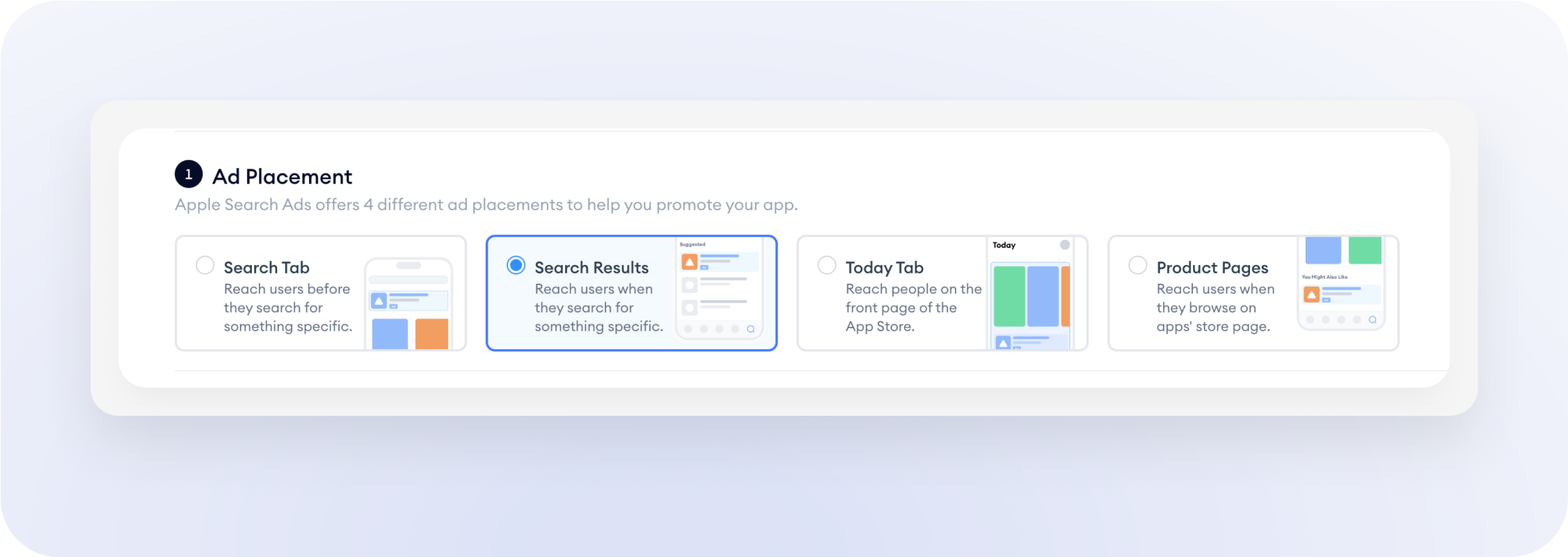
Scope and Levels: You can build automation rules for all four Apple Ads placement types (Search results, Search tab, Today tab, and Product pages) across six levels of your account structure:
- Campaign group level – rules affecting all campaigns in a group.
- App level – rules scoped to a specific app’s campaigns.
- Campaign level – rules targeting individual campaigns.
- Ad group level – rules within specific ad groups.
- Keyword level – rules for keywords (available for search results ads only).
- Search term level – rules for search terms (available for search results ads only).
Keywords and search terms levels are only available for the search results ads due to the nature of the placement.
Automations can perform distinct actions when your conditions are met. These actions help you not only monitor performance but also automatically adjust your campaigns.
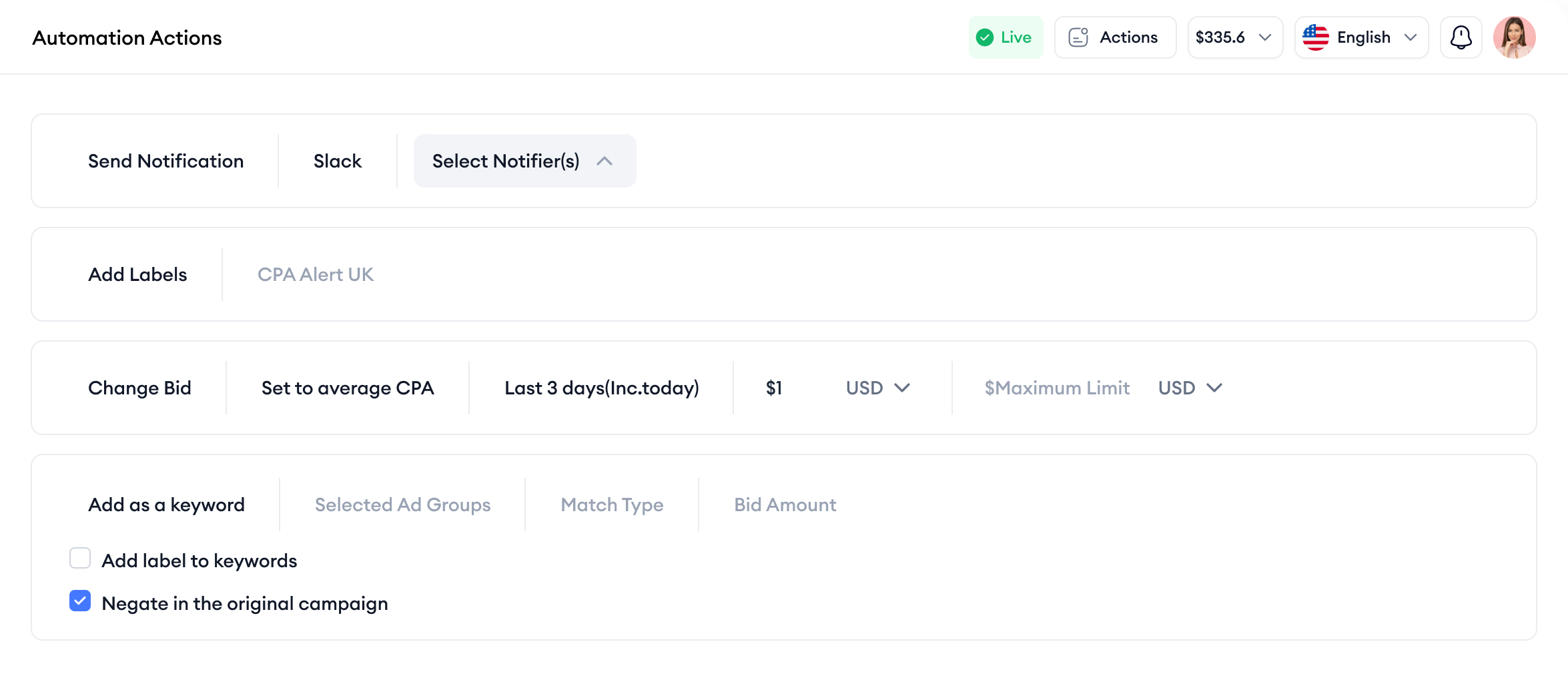
Depending on the rule, Automations can:
- Send email notifications: Get an email alert sent to specified addresses whenever an automation is triggered. This is useful to keep stakeholders informed of important changes or performance issues, even when they’re away from the dashboard. (Available at all levels.)
- Send Slack notifications: Similarly, push a notification to a chosen Slack channel in real time when conditions are met. This keeps your team instantly informed for collaborative monitoring. (Available at all levels.)
- Pause campaigns or ad groups: Automatically pause a campaign or ad group if certain criteria are met. For example, pause an ad group if its CPI exceeds your target, thereby preventing further spend. (Available at campaign and ad group levels.)
- Activate campaigns or ad groups: Conversely, resume or activate a paused campaign/ad group when conditions allow. This is great for seizing opportunities—for instance, re-activating a campaign in a profitable time window without manual intervention.
- Change campaign lifetime budget: Adjust the lifetime budget of a campaign on the fly. Automations can increase or decrease the total campaign budget to align with performance or timeframe goals (e.g., extend the budget when ROI is good). (Campaign level.)
- Change campaign daily budget: Modify the daily spend cap of a campaign. For example, lower the daily budget if weekly spend is too high, or raise it when performance is strong. This provides flexibility to respond to daily trends. (Campaign level.)
- Change bids: Tweak the bid amounts at the ad group (default bid) or keyword level based on performance rules. For instance, raise bids on keywords with a high conversion rate, or lower bids on those with a low ROI. (Ad group level for default bids; keyword-level bid changes are typically achieved via keyword-level automations.)
- Change CPA caps: If you’re using CPA (Cost-Per-Acquisition) goals, an automation can adjust the CPA target cap for an ad group. For example, tighten the CPA cap if quality is low, or loosen it to capture more volume when performance is efficient. (Ad group level.)
- Add a label to keywords: Automatically label certain keywords based on performance. For example, tag keywords as “High CPA” or “Star Performer” according to the criteria you set. This helps organize and filter keywords for analysis. (Keyword level.)
- Add as a keyword: Take a high-performing search term and add it directly to your keyword list. Automations can identify search terms that are converting well and promote them to permanent keywords in your campaign, ensuring you bid on them proactively. (Search term level.)
- Add as a negative keyword: Conversely, add specific terms as negative keywords to prevent wasteful spend. For instance, if a search term is irrelevant or has a poor ROI, an automation can automatically add it as a negative keyword at either the keyword or search term level. (Available at keyword and search term levels.)
Automations not only reduce the manual labor of micromanaging campaigns but also enhance performance by allowing you to respond quickly to changing metrics. Instead of waiting for a human to notice and react to a trend, the system can make adjustments in near real-time, keeping your campaigns on track toward your goals.
Note: Automations will not override certain Apple Ads management features:
- If a campaign is part of a Budget Allocation group, certain automation actions (such as changing the daily budget or pausing the campaign) will not be executed. In these cases, the system will notify you that the automation could not proceed (because the Budget Allocation group controls the budget).
- For campaigns or ad groups using Smart Bidding, any automation rule set to change keyword bids will not take action. Smart Bidding manages bids automatically, so manual bid changes (even via automation) are restricted.
In conclusion
Automations eliminate the burden of repetitive manual work, allowing you to focus on strategy while your campaigns optimize themselves in real-time. From protecting your brand terms to scaling budgets with precision, Automations keep your marketing goals on track without constant oversight.
As we told through our guide, the answer to the question of how to automate Apple Ads is simple. With SearchAds.com by MobileAction, you get access to 20+ editable automation templates and gain the flexibility to build custom multi-layered rules around the metrics that matter most to your app. Whether you’re targeting controlled growth, safeguarding performance, or maximizing ROI, Automations ensure your Apple Ads campaigns run with consistency, agility, and confidence.
Ready to take the next step? Start using Automations with MobileAction today for free and transform the way you manage Apple Ads.
More resources on Apple Ads
[Report] MobileAction’s 2025 Apple Ads benchmark report
[Blog] Best Apple Ads tools for app marketers: Boost visibility and ROAS
[Blog] WWDC 2025: The releases UA practitioners should actually care about
[Guide] The ultimate guide to Apple Ads by MobileAction
[Webinar] Custom Product Pages: What’s New and What Actually Works
Frequently asked questions
How does automation work within Apple Ads?
Automation in Apple Ads works through rule-based logic. You define conditions and actions. Automations continuously monitor campaign performance, checking metrics like impressions, taps, installs, conversion rate, or even custom KPIs from your Mobile Measurement Partner (MMP). When conditions are met, the system automatically applies the specified actions, adjusting bids, budgets, pausing or activating campaigns, labeling keywords, or sending alerts.
How can I automate campaign management in Apple Ads?
You can automate campaign management in Apple Ads by using MobileAction’s Automations.
How can automation improve performance and save time?
Automation improves performance by enforcing your strategy consistently. It reacts instantly to data, reallocating budgets, refining bids, and protecting brand terms without waiting for manual checks. That means less wasted spend, better cost efficiency, and stronger Share of Voice in competitive categories.
How frequently should I set actions?
Deciding how often to set your automation actions really depends on what you’re aiming to achieve with your campaign and how your key performance indicators (KPIs) are behaving. If you need to stay on top of rapid changes, setting a higher frequency for your actions might be the way to go.
On the other hand, if your campaign is more consistent, a lower frequency could work just fine. It’s all about matching the settings with the dynamics of your campaign to ensure the best outcomes.
How frequently should I check my automation rules?
Even with automation in place, human oversight is essential. As a best practice:
- Weekly: Review automation logs and labels to ensure rules are firing as intended, thresholds aren’t too tight, and no campaigns are over-adjusting.
- Daily (for aggressive campaigns): Check for budget caps, sudden CPA shifts, or Share of Voice drops.
- Quarterly: Audit your rule set, retire outdated ones, and refine thresholds as your business goals evolve.
In short, automation isn’t “set and forget.” The rules execute reliably, but reviewing them regularly ensures they remain aligned with your KPIs and market conditions.
How can I optimize with automations towards the lower-funnel?
It’s essential to focus on specific events reported by your Mobile Measurement Partner (MMP). These events are pivotal because they track user actions that directly correlate with your business goals, such as installs or purchases. You can implement custom columns in your campaign management setup. This allows you to monitor custom KPIs that are significant to your company’s objectives.
For instance, if an increase in purchases is a goal, you can track this metric closely through a custom column based on an MMP event that reflects this particular data.
Will automation take place on paused elements in my campaigns?
The only action that automations will take on paused elements is to activate them. This means that if you have set up an automation rule to apply across all campaigns under all campaign groups, it will not automatically adjust bids on campaigns or keywords that are paused.
Once a paused element, such as a campaign or keyword, is activated by automation, any subsequent rules that involve bid changes will then apply. For example, if there’s an existing automation for bid adjustment, it will take effect only after the campaign element has been reactivated.
This handbook will serve as your roadmap, packed with emerging trends, valuable insights, and the best ASO tools & resources. It aims to help you stay ahead of the competition and enhance your app marketing strategy for substantial growth in 2025 and beyond.




























